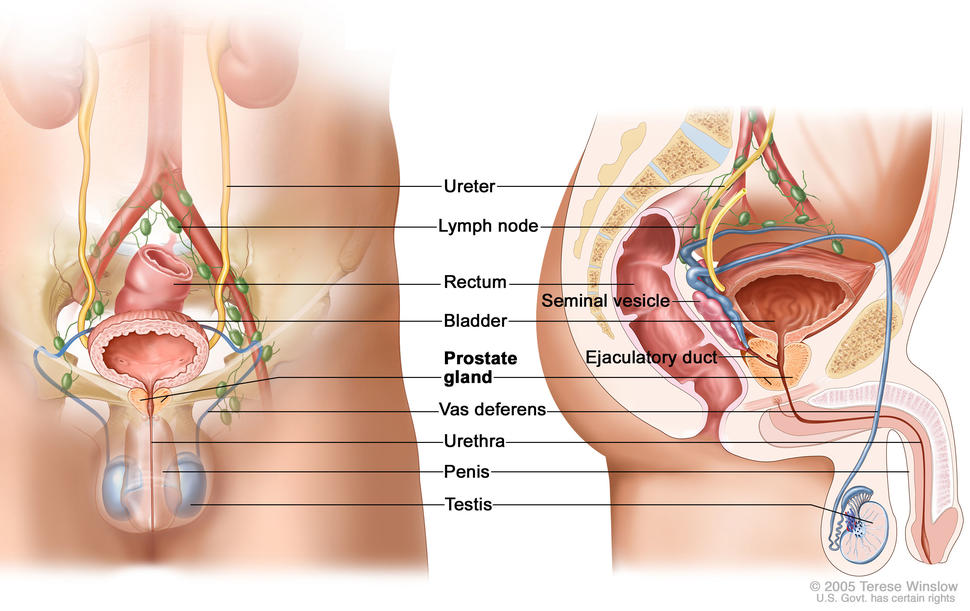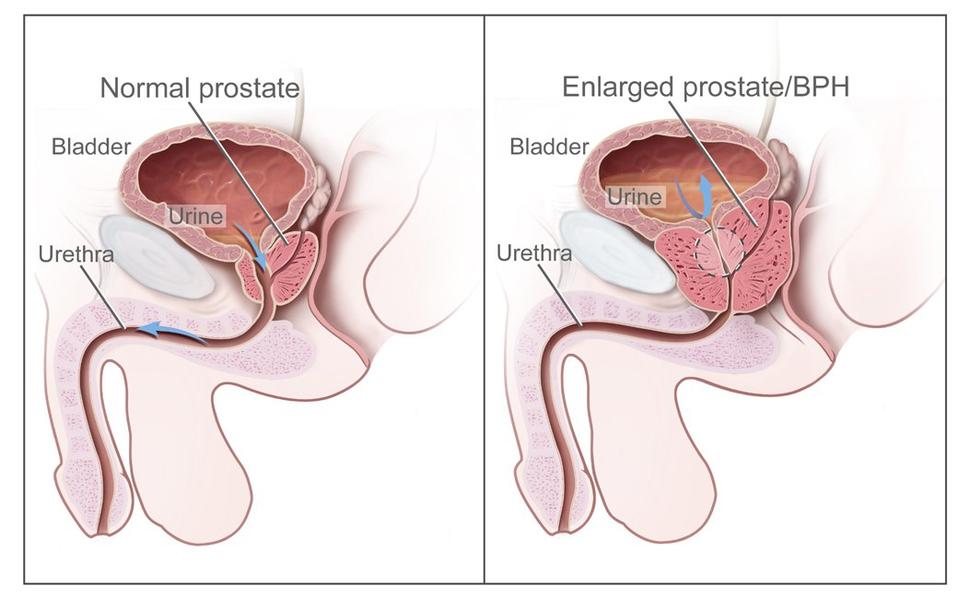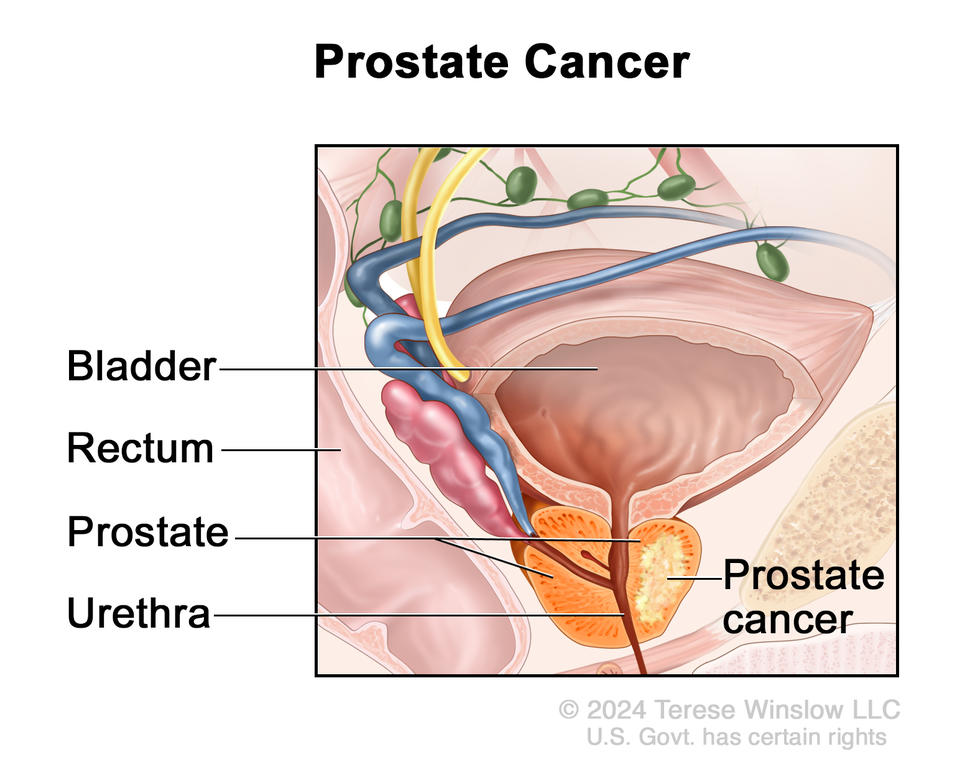About the prostate and prostate changes
The prostate is part of the male reproductive system. The prostate tends to grow larger as a man ages. When men are in their 20s, the normal prostate is about the size of a walnut. By the time a man is 40 the prostate may have grown slightly larger, and by age 60, the prostate is often the size of a lemon. Age increases the risk of prostate problems, such as BPH and prostate cancer.
Where is the prostate located?
The prostate gland is located below the bladder and in front of the rectum. The prostate surrounds part of the urethra, a tube that carries urine out of the bladder and through the penis.
What does the prostate do?
The prostate is a gland that helps make semen, the white, milky fluid that carries sperm when a man ejaculates. Muscles in the prostate push semen into the urethra and out, through ejaculation.
What are symptoms of prostate changes?
Benign prostate conditions can cause symptoms such as frequent or the sudden need to urinate (pee) especially at night, pain or burning while urinating, a weak stream of urine, difficulty urinating, blood in the urine or semen, and painful ejaculation.
What tests are used to diagnose prostate problems?
Diagnostic tests can determine if your symptoms are caused by prostate cancer, a benign prostate condition, or other condition such as a urinary tract infection (UTI). Your doctor will do a physical exam and ask about symptoms such as pain, fever, or trouble passing urine—as well as how long you’ve had these problems and how much they are affecting you.
What to expect during a prostate exam
Based on your symptoms, your doctor may advise a digital rectal exam, blood tests such as the prostate-specific antigen (PSA) test, and a urinalysis. Your doctor may refer you to a urologist, a doctor who specializes in diagnosing and treating diseases of the urinary and reproductive organs in males and the urinary organs in females. Learn more about prostate tests that may be used to check for prostate problems.
If you have a PSA test and your PSA level is high, your doctor will talk with you about next steps. A high PSA level can be caused by many things, including:
- some benign prostate conditions
- urinary tract infections
- having a digital rectal exam
- having a prostate biopsy
- disturbance to the prostate (from bike riding, for example)
- prostate cancer
Learn more about the PSA test.
What is prostatitis?
Prostatitis is a benign condition that involves inflammation of the prostate. Prostatitis does not increase your risk of prostate cancer. It is the most common urinary condition in men younger than age 50 and affects at least half of all men at some time during their lives. Prostatitis can raise a man’s PSA level.
Signs and symptoms of types of prostatitis
There are four major types of prostatitis. Each type has unique symptoms and causes.
Acute bacterial prostatitis is caused by a bacterial infection. It is the least common type of prostatitis. Symptoms begin suddenly, get worse quickly, and may include
- fever, chills, body aches, nausea, or vomiting
- burning when urinating, frequent, sudden, or urgent need to urinate (pee), difficulty urinating, or a weak urine stream
- pain in your lower belly (abdomen), groin, genitals, or lower back
Sometimes this type of prostatitis can block the urinary tract, and you may be unable to urinate. Seek treatment right away for symptoms of acute bacterial prostatitis.
Chronic bacterial prostatitis is also caused by a bacterial infection. Symptoms are similar to those of acute bacterial prostatitis but are less severe. Unlike acute bacterial prostatitis, chronic bacterial prostatitis symptoms may come and go or get worse slowly, over several months. Men with chronic bacterial prostatitis often have urinary tract infections (UTIs) that keep coming back after treatment.
Chronic prostatitis/chronic pelvic pain syndrome is diagnosed in men of all ages who have pain that lasts more than three months, including:
- pain in the genital area, lower abdomen, or lower back
- pain when urinating, the need to urinate often, or a weak flow of urine
It is the most common but least understood type of prostatitis. Infection-fighting cells (white blood cells) are often found in the prostate fluid and semen.
Asymptomatic inflammatory prostatitis doesn’t cause symptoms, although white blood cells are detected in the prostate fluid and semen. This condition is often found during testing for other conditions, such as infertility or prostate cancer.
Learn about treatment for different types of prostatitis.
What is benign prostatic hyperplasia (BPH)?
Benign prostatic hyperplasia (BPH) (also called an enlarged prostate) is an overgrowth of prostate tissue. Its name comes from benign (not cancer) and hyperplasia, which means there are an increased number of cells in the prostate gland.
Signs and symptoms of an enlarged prostate (BPH)
Because an enlarged prostate can push against the urethra and the bladder, it may cause urinary symptoms, such as:
- the need to urinate more often, especially at night
- pushing or straining to begin a urine stream
- feeling that the bladder has not fully emptied
- the strong or sudden need to urinate
- weak, slow, or dribbling stream of urine
- trouble urinating; stopping and starting multiple times while passing urine
- painful urination
- pain after ejaculation
- blood in the urine
Symptoms related to BPH are one of the most common reasons that older men make an appointment to see a urologist.
An enlarged prostate does not increase a man’s risk for prostate cancer. However, people with an enlarged prostate have an increased risk of prostatitis. Over time, if it’s not treated, BPH can lead to a weak bladder, a backflow of urine that can cause bladder or kidney infections, or a blocked flow of urine, which can cause kidney failure.
Treatment for an enlarged prostate
Although BPH cannot be cured, medicine or surgery can reduce symptoms and help you feel better. Your doctor will talk with you about treatment options, which are based on the results of medical tests, the size of the prostate, your overall health, and your personal preferences.
If your symptoms are mild, your doctor may advise practical steps you can take at home, such as drinking less fluids, especially those with alcohol or caffeine, before bedtime. You may also read about herbal or natural remedies. But such remedies may not help and can possibly cause harm. Before trying any supplements, you should check with your doctor. Their advice may depend on other medications you take and your personal medical history.
Your doctor may also suggest medications. Drugs such as alpha-blockers may be used to relax the muscles near the prostate, and 5-alpha reductase inhibitors may be used to shrink the prostate gland. For severe BPH symptoms or if medicine has not worked well, your doctor may talk with you about minimally invasive procedures or surgery.
Learn more about treatment options for benign prostatic hyperplasia (BPH) and about ongoing BPH clinical trials.
What is prostate cancer?
Prostate cancer is cancer that forms in tissues of the prostate.
Prostate cancer risk factors
Risk factors for prostate cancer include:
- being 50 years or older
- having a first-degree relative (a father, brother, or son) with prostate cancer
- inherited gene changes, such as having BRCA1 or BRCA2 gene mutation or Lynch syndrome
- race and ethnicity; prostate cancer develops more often in African American men
- history of smoking
BPH and prostatitis are not risk factors for prostate cancer. Learn more about risk factors and protective factors for prostate cancer.
Can prostate cancer be detected early?
PSA testing is sometimes used to screen for prostate cancer. There are both possible benefits and harms to screening, and men who are considering screening should talk with their doctor to see if screening is right for them. Learn more about the prostate-specific antigen (PSA) test.
Symptoms of prostate cancer
Early-stage prostate cancer does not usually cause symptoms. However, locally advanced prostate cancer may cause urinary symptoms including blood in the urine or semen or pain in the back, hips, or pelvis that doesn’t go away. Learn more about signs of prostate cancer.
Treatment for prostate cancer
Treatment options for prostate cancer are based on your specific diagnosis. Standard treatments for prostate cancer include watchful waiting or active surveillance, surgery, radiation therapy, hormone therapy, chemotherapy, targeted therapy, and immunotherapy, among others. There are also new treatments for prostate cancer that are being tested in clinical trials. Learn about prostate cancer treatment.
Talk with your doctor about prostate health
Questions to ask your primary care doctor or urologist
- What prostate condition or disease do I have?
- What type of treatment do you recommend for my prostate problem?
- What are possible side effects that men have from this procedure or treatment?




